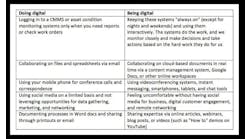Perspectives Part Two: COVID-19 & manufacturing
We are all dealing with the COVID-19 pandemic in our own ways, but struggles for members of the manufacturing community share similarities. With that in mind, we solicited insights on a few topics from a broad spectrum of industry stakeholders in order to provide perspectives that can help you navigate this unprecedented period.
This is Part Two of a series. Find the full feature here.
HOW HAS THE MANUFACTURING SECTOR RESPONDED TO THIS CRISIS?
“Half of the manufacturing sector is faring well, while the other half has quickly realized that they have been behind the eight ball. For the companies that have already added a certain degree of automation and remote access to critical business applications, the coronavirus is acting as an external validator. These companies’ workforces have the ability to manage systems from their web browsers on home computers, tablets and even smartphones, enabling their business to continue running uninterrupted. On the other hand, the companies that haven’t automated these processes are forced to shut down until they can upgrade their operations capabilities or physically return to the job site.” Frank Kenney, director of market strategy, Cleo
“Smart manufacturers have been able to change material production and container sizes very quickly. The facilities that had instituted flexible-manufacturing philosophies have been able to respond to this crisis, and to them it is business as usual. Just making something different.” Linda Freeman, industry manager, Rockwell Automation
“It’s clear that manufacturing is rising to the occasion: taking necessary steps to continue operations where possible so that we minimize the impact on our economy and keep employees working. There appears to be a collective understanding that we are in this together, and that by each doing our part we will get through this pandemic.” Benson Hougland, vice president of marketing & product strategy, Opto 22
“So far it is business as usual with my supply chain. It appears most are ready, willing, and able to keep going but it also seems difficult to pivot operationally to fill certain voids, like making respirators. In my Vistage manufacturing network I hear many comments by other business owners that they have capacity and would like to be of service but I see no organized effort to utilize yet.” Juliet Goff, president and CEO, Kal Plastics
“We have been amazed at how the manufacturing sector has responded. Our customers who make medical devices and respirator parts have doubled down to increase production (a feat that must be difficult when staff is cut short and suppliers may be limited). We even have several customers that are making respirator and other key medical devices despite historically only making aerospace or automotive parts. It’s always great to see a community come together!” Eric Fogg, co-founder and chief connectivity officer, MachineMetrics
“In a time when manufacturers were focused on streamlining system integrations, the COVID-19 pandemic quickly modified the focus of those plans to the procurement of supplies to maintain even reduced levels of manufacturing due to restricted travel, abandoned shipments and delays of 4–6 weeks in receiving shipments. These delays may cause pricing spikes as well as encourage the diversification of supply chain parts to a variety of locations around the globe, such as India or other countries outside of the Asia-Pacific arena.” Romil Bahl, president and CEO, KORE
“As has been reported in the media, many oil and chemical producers have already announced reductions in their capital-spending programs for the next fiscal year. This will impact their entire supply chain, from crews drilling new wells to planned refinery enhancements, and will hit equipment vendors, engineering firms and, in the longer term, consumers. Crews in West Texas have already been laid off. The entire ecosystem will take a hard hit for at least 12-18 months. Given how hard it is to start/stop these large-scale projects, it will not be a quick fix, even if the actual pandemic passes in one or two quarters.“ Paul Donnelly, industry marketing director, Aspen Technology
“I’ve been encouraged by the level of resilience and flexibility our customers have demonstrated while remaining innovative in how they keep work going. In challenging and unprecedented times like these, it is vital to band together and unite around helping each other out. There are manufacturers that are completely switching their production focus and increasing capacity to ensure our healthcare workers on the front lines have the equipment they need to treat COVID-19 patients. There are countless more workers who are faced with uncertainty but rise to the occasion, and one of our key priorities is supporting these customers to ensure that critical infrastructure continues to operate day to day.” Pat Byrne, CEO, GE Digital
“The manufacturing sector has embraced this challenge and its role in keeping our infrastructure strong and running. Manufacturers make up the backbone of this country, and so far they have been up to this test. I’m sure that direct manufacturers of PPE and medical devices are feeling more pressure; they are focused on producing the most critical items for the health-care facilities.” Chris Wilder, CEO, Sealing Equipment Products Company (SEPCO)
“Many in the manufacturing sector, along with other industries, had employees and contractors in infected areas forced to undergo work-from-home or other restrictions that required increased remote- access capacity. With size and location, that was not anticipated or planned for, so this required them to pursue immediate procurement, deployment and flexibility. Most organizations have enhanced their visibility capabilities, but are not yet at a point to provide more granular access and ensure endpoint compliance of those accessing their systems. In addition, many manufacturers were not prepared for a significant increase in remote access to service ICS devices, nor had they adequately orchestrated emergency-access controls between their IT and OT systems.” Scott Gordon, CMO, Pulse Secure
“Laborers are being furloughed and fired. It’s never an easy decision to press that stop button on the line and to send workers home because you know it means that completed goods/material/units are not going out that door to be shipped to customers. But it’s the right decision and they have handled it well. We have to keep people safe and healthy.” Chris Catterton, director of solution engineering, ONE Tech, Inc.





